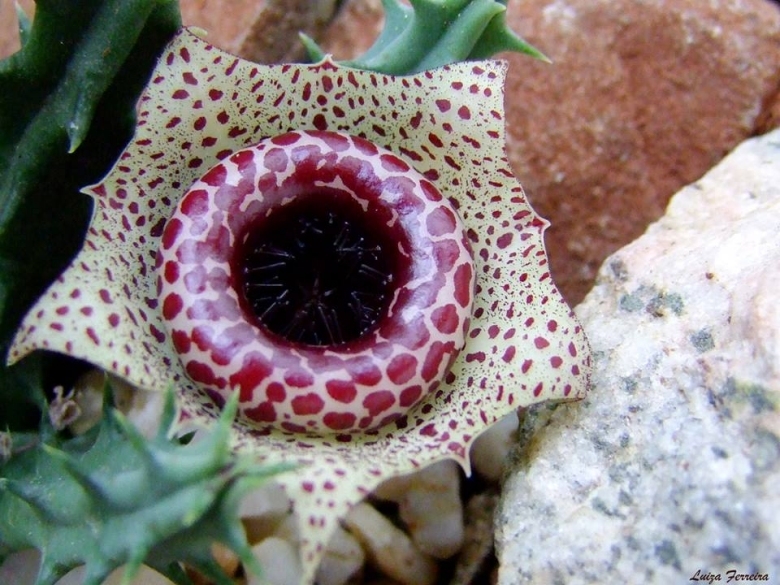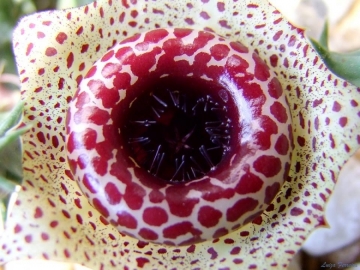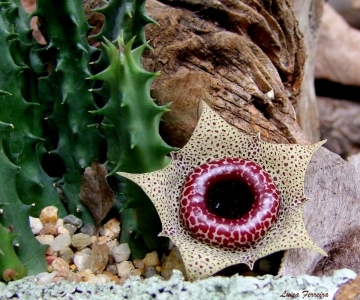Accepted Scientific Name: Huernia guttata (Masson) R.Br. ex Haw.
Syn. Pl. Succ. 30 30 1812

Huernia guttata subs. calitzdorpensis Photo by: Luiza Ferreira
Origin and Habitat: Huernia guttataSN|22523]]SN|22523]] subsp. calitzdorpensis occurs in the Western and Eastern Cape, Republic of South Africa (Little Karoo from Calitzdorp to Oudtshoorn).
Synonyms:
See all synonyms of Huernia guttata
back
Accepted name in llifle Database:Huernia guttata (Masson) R.Br. ex Haw.Syn. Pl. Succ. 30 30 1812Synonymy: 11
Accepted name in llifle Database:Huernia guttata subs. reticulata (Masson) BruynsStapeliads S. Africa Madagascar 1: 181. 2005Synonymy: 7
back
Description: Huernia guttataSN|22523]]SN|22523]] ssp. calitzdorpensis is a local or morphological form distinguished from subsp. guttata by its larger, darker flowers up to 7 cm across, the tube is dark maroon, occasionally marked with some vague yellowish lines, the hairs at its throat much longer and more strongly clavate. However the minimal differences in floral structure of subusp. calitzdorpensis, appears to fall within the natural variation of Huernia guttataSN|22523]]SN|22523]] subsp. guttata and it should be fully synonymized it.
Subspecies, varieties, forms and cultivars of plants belonging to the Huernia guttata group
 Huernia guttata (Masson) R.Br. ex Haw.: (subsp. guttata) although variable it has smaller flowers, spotted or lined tube and dull annulus with short inwardly pointed hairs at the tube mouth. Distribution: Eastern Cape, Northern Cape, Western Cape.
Huernia guttata (Masson) R.Br. ex Haw.: (subsp. guttata) although variable it has smaller flowers, spotted or lined tube and dull annulus with short inwardly pointed hairs at the tube mouth. Distribution: Eastern Cape, Northern Cape, Western Cape. Huernia guttata subs. calitzdorpensis L.C.Leach: has larger, darker flowers up to 7 cm Ø, tube dark maroon, marked with vague yellowish lines, hairs at its throat longer and strongly clavate. Distribution: Little Karoo from Calitzdorp to Oudtshoorn
Huernia guttata subs. calitzdorpensis L.C.Leach: has larger, darker flowers up to 7 cm Ø, tube dark maroon, marked with vague yellowish lines, hairs at its throat longer and strongly clavate. Distribution: Little Karoo from Calitzdorp to Oudtshoorn- Huernia guttata subs. reticulata (Masson) Bruyns: Distribution: Northern Cape, Western Cape
Bibliography: Major references and further lectures
1) Doreen Court “Succulent Flora of Southern Africa” CRC Press, 01 June 2000
2) Focke Albers, Ulrich Meve “Illustrated Handbook of Succulent Plants: Asclepiadaceae: Asclepiadaceae” Volume 4 Springer Science & Business Media, 2002
3) SANBI. 2014. "Huernia guttata (Masson) Haw. subsp. calitzdorpensis L.C.Leach." National Assessment: Red List of South African Plants version 2014.1. Accessed on 2015/02/23
 Huernia guttata subs. calitzdorpensis Photo by: Luiza Ferreira
Huernia guttata subs. calitzdorpensis Photo by: Luiza Ferreira - JJS 151Calitzdorp dam Photo by: Luiza Ferreira
- JJS 151Calitzdorp dam Photo by: Luiza FerreiraCultivation and Propagation: Huernia guttataSN|22523]]SN|22523]] subs. calitzdorpensis isn't difficult to grow and flower.
Spring: When winter ends and they begin to grow again, they will require much water and soaking the pots will no longer put the plants at risk for rot. In the spring they will grow well in partial shade and leaving them out in the rain may provide them with the water they need.
Summer: In the summer months they will tolerate heavy rain, but will be just as happy if the season is dry. It's best to sort out the stems while the plants are resting in the summer before they begin their autumnal growth cycle. They will tolerate very hot weather outdoors as long as they are kept in filtered light and this will encourage them to flower in the Autumn. They also enjoy some fertiliser. Moving the plants as they are developing buds may cause them to spontaneously abort the flowers all together.
Autumn: In the fall keep them outdoors until the night time temperatures drop below the 10°C.
Winter: Winter care presents no problems at 10° C with plenty of light. As soon as they are flowered be sure to take extra precautions to keep them dry, because damp cool conditions when the plants are resting is an invitation to fungal infections, but - according to temperatures –some occasional lit watering may be useful.
Potting medium: Since roots are quite shallow, use a cactus mix or add extra perlite or pumice to regular soil potting soil. A gritty, very free-draining compost is suitable, and clay pots help the plants to dry out between watering. Re-pot every 2 years.
Pest and diseases: Huernia are generally fairly easy to grow, especially if kept pest-free. They are very susceptible to stem and root mealy bugs, and damage from these may well initiate fungal attack. Any time when there is a dead or dying stem in the pot it is important to remove it immediately and completely before other healthy stems can become ill too, isolate the healthy parts, dry them off, and re-root them in new compost.
Propagation: Easiest with stem cuttings. Allow cuttings to dry a day before planting. Stems must be laid (Not buried) on gritty compost and will then root from the underside of the stems. It can also be increased from seeds sowing in spring in moist, sandy peat moss. Barely cover seeds. Seeds germinate quickly.
In any season it's best to lay the stems out for several days before replanting them and then pot them only in dry soil and withhold any water until they begin to shrivel or start growing again.












